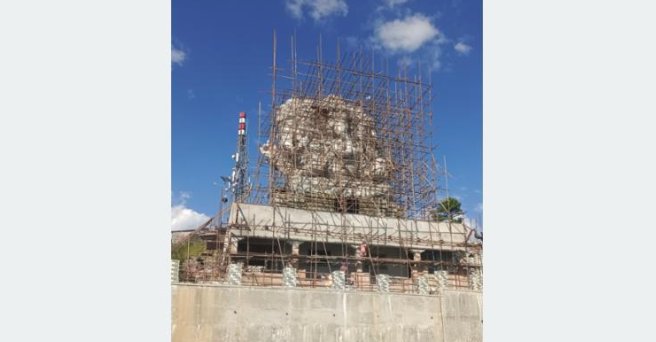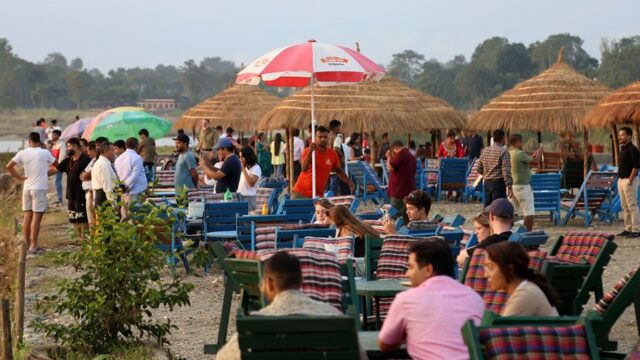Nestled in Pokhara-18, Sarangkot, renowned for its breathtaking views of the Himalayas and stunning sunrises, is evolving into a significant religious tourist destination. This transformation is largely attributed to the ongoing construction of a 61-foot-tall Panchmukhi Ganesh statue, which is expected to enhance tourism in the area.
Sarangkot has long been a favorite among tourists for its panoramic views of Annapurna, Dhaulagiri, and Machapuchare mountains, along with mesmerizing sunrise and sunset experiences. Recent developments in infrastructure and religious structures have not only accentuated the natural beauty but also attracted religious tourists to the site.
The Sarangkot Religious and Tourism Development Committee has undertaken the construction of this infrastructure on a 56 ropani plot of land. According to the committee’s chairman, Prem Bahadur Jisi, a total investment of NPR 400 million is being made under the comprehensive Sarangkot religious tourism master plan. To support this initiative, the committee has successfully raised NPR 7 million through five major religious events, while government investments have totaled NPR 45 million, including NPR 30 million from the Pokhara Metropolitan City.
The construction of the Ganesh statue is being overseen by Kalu Gurung, the chairman of Annapurna Cable Car, who is actively securing financial resources to push the project forward. An estimated NPR 70 million is allocated for both the Ganesh statue and the construction of Sahasradhara.
So far, over NPR 220 million has been invested in the area’s infrastructure, which features a variety of religious and cultural attractions. These include the Kailasheshwar Shiva Temple, 108 Shiva Lingas, Sahasradhara, Bhairav Temple, Chandi Temple, Bhimkali Temple, a religious assembly hall, a historical entrance gate, organized toilets, and a viewing tower.
Historically, the name Sarangkot is linked to its use as a weapons storage area by the Shah dynasty. Additionally, it was known as a training ground for soldiers and police in the past.
Committee member Krishna Thapa expressed confidence that the newly constructed infrastructure with historical and religious significance will significantly contribute to tourism promotion. He highlighted the importance of the Bhumekali Temple, which has been a pilgrimage site for many devotees from Pokhara and surrounding areas. He believes that the construction of the Shiva and Ganesh temples will further enhance the faith and attraction of Hindu devotees.
The project, implemented with coordination among various organizations, will be named Shiv Panchmukhi Ganeshdham, aiming to establish the area as a new destination for religious and cultural tourism. Rabindra Makaju, president of the Sanatan Dharma Service Committee, stated that the construction of the Panchmukhi Ganesh statue, a first of its kind in the country, will create new opportunities for religious tourism and add a new chapter to Pokhara’s tourism narrative. He emphasized that Sarangkot could become an attractive destination for Hindu pilgrims from India and other countries due to its blend of natural beauty, adventure tourism, and religious faith.
The belief in the Panchmukhi Ganesh statue is that it will remove obstacles and bring prosperity and success, which is particularly appealing to South Indian tourists who hold a strong reverence for Lord Ganesh.
Biplav Poudel, executive director of Sarangkot Mountain Lodge and a former member of the Nepal Tourism Board, expressed optimism that the expanded infrastructure will support tourism in both Pokhara and Sarangkot. He noted that Sarangkot is already a tourist destination and that recent developments, including the Shiva Temple and Ganesh statue, would further invigorate tourism in the area. Poudel also highlighted that the promotion of tourism would impact local businesses, especially in expanding the hotel and homestay sectors, while also calling for attention to the challenges that come with development, including sustainable management of tourist infrastructure.
Dhanraj Acharya, the mayor of Pokhara Metropolitan City, emphasized ongoing efforts to develop Pokhara as a multi-dimensional tourist hub through religious and spiritual infrastructure. He mentioned that the captivating views of the Himalayan range, Fewa Lake, and the Pokhara valley, alongside recent developments like the Panchmukhi Ganesh statue, Shiva temple, and viewing tower, are enhancing the area’s tourist significance. He expressed confidence that Sarangkot will become a center for both sunrise viewing and religious and cultural tourism.
Acharya believes that the combination of Sarangkot’s natural beauty, religious significance, and cultural heritage will greatly support sustainable tourism promotion. He asserted that the experience of witnessing the Himalayas alongside visiting religious sites will extend tourists’ stays in Pokhara.
As a popular tourist capital, the development of new destinations in Pokhara is essential, and Acharya confirmed that the metropolitan city is continuously investing in this initiative, with over NPR 30 million already allocated for the Sarangkot area alone.
Source: RSS






